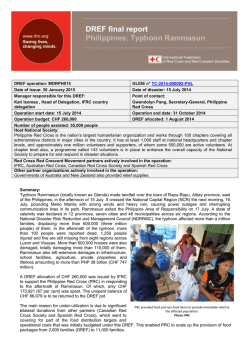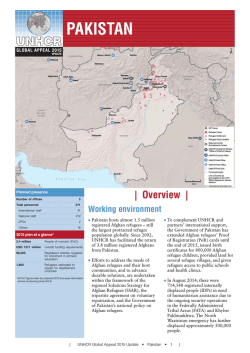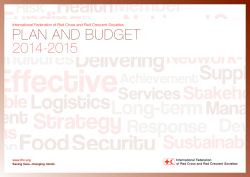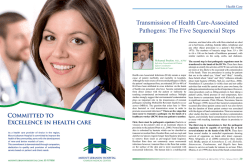
Population Movement - International Federation of Red Cross and
Emergency appeal operations update Ethiopia: Population Movement Operations Update n° 1 Period covered by this Operations December 2014/January 2015. Operation n° MDRET015 Update: Glide n° OT-2014-000001-ETH Date of issue :31 January, 2015 Operation start date: 22 December, 2014 Point of contact: Hagos Gemechu; Deputy General Secretary for programmes Operation end date:22 September, 2015 (Expected timeframe: 9 months) Appeal budget: CHF 1,050,574 Appeal Coverage to date:9 % DREF allocated:CHF 150,000 Number of people affected: 245,0000 refugees Number of people to be assisted: 34,365 Persons Host National Society: Ethiopian Red Cross Society Red Cross Red Crescent Movement partners actively involved in the operation: IFRC, ICRC, Swiss Red Cross Other partner organizations actively involved in the operation: UN Refugee Agency (UNHCR), Ethiopian Government Administration of Refugees and Returnees Affairs (ARRA), UNICEF, World Food Programme (WFP) International Organization for Migration (IOM), World Health Organization (WHO), Norwegian Refugee Council (NRC), Danish Refugee Council (DRC), ACF, Medecin Sans Frontier (MSF), ACT Alliance and IMC. Appeal History: This Emergency Appeal was launched on 30 December, 2014 for CHF 1,050,574 for 9 months to support Ethiopia Red Cross provide assistance to some 34,365 persons to reduce the health risks of the South Sudan refugee population and host communities in Gambella through the provision of first aid and community-based health in Leitchour camp, Ningnang and Pagak entry points. Disaster Relief Emergency Fund (DREF): CHF 150,000 was initially allocated from the Federation’s DREF to support the national society to respond. This update provides information regarding the operation 1 month since the launch. Summary: The refugees from South Sudan continue to arrive in Ethiopia, mainly into the Gambella Regional State through three border entry points citing fighting and food insecurity as the main reasons for their flight, in addition to citing human rights abuses and lack of basic services. As of 12 December 2014, UNHCR records indicate that 191,659 people have now arrived in the Gambella region since January. The average arrival rate of has dropped significantly with commencement of rains in various locations in the Gambella region and in South Sudan, making access to border entry points difficult. Whereas the average arrival rate is more than 25,000 over the entire year only 1,426 South Sudanese refugees arrived in Ethiopia during the month of October, and 420 in November. Yet, numbers are expected to resume once again once flood water recede as the situation in South Sudan is not improving. The National Society and IFRC are in discussion with Administration for Refugee and Returnee Affairs (ARRA) and UNHCR on operational areas as there is continued lack of clarity around camp locations and the future plan for Leitchor camp and Pagak entry point will be closed. Additionally ERCS and IFRC spent the weeks following the launch of the emergency appeal negotiating operational space with ARRA and UNHCR as well as preparing the ground for recruitment of staff and engaging potential donors in support of the operation. Page |2 The IFRC, on behalf of the Ethiopia Red Cross, would like to thank all those that have contributed to this Emergency Appeal, including Danish Red Cross/ Danish Government and Japanese Red Cross Society. Other donors are encouraged to support the Appeal to enable ERCS provide assistance to the targeted beneficiaries through the planned activities as detailed in the Emergency Plan of Action (EPoA). <click here to view the contact details and here to go directly to the donor response report > The Situation Overview The Ethiopian Government confirmed the location of two new camps in Gambela region and the two sites require development namely; Koben (43km from Gambela town) and Cholan (18km from Gambela town).The UNHCR is currently conducting site assessments and developing the matrix for operational activities and partners.Additionally,the Government confirmed that Pagak entry point will be closed and as such partners continue to express concern over this closure because from assessments carried out it was noted that the refugees continue to arrive in Ethiopia into the Gambella Regional State, mainly through Pagak (49%), Burbiey (24%), and Akobo (22%) border entry points.Furthermore,it is unclear what is the fate of Leitchor camp and partners continue to provide services until further notice. Negotiations with ARRA and UNHCR continue while activities on a small scale also continue in Leitchor camp through existing volunteers and staff. Restoring Family Link (RFL) is ongoing with ICRC and ERCS and Swiss RC longer term development project is underway. Staffing: To date, a RDRT alert has been launched twice and the delegate position (Operations Support Delegate) has been posted online and shared with partners. Additionally, ERCS has developed job descriptions and has posted the local positions for Gambela Operations Unit. IFRC will support ERCS with recruitment. Appeal funding: On January 22, 2015, a donor teleconference was held with ERCS, IFRC and PNS participation. The purpose of the call was to follow up on the initial teleconference in December to share up to date information on the situation in Gambela and to respond to queries potential partners had expressed. During the call partners confirmed their interest in supporting the appeal. Meetings have been held in Nairobi and Addis with potential PNS contributors. An application was submitted to ECHO and the appeal was shared with PRM in Washington DC and DFID in Addis. Meetings with PRM and DFID in Addis are being scheduled. The number of refugees in Ethiopia is over 660,987 individuals, with the number increasing on a daily basis due to the current influx from South Sudan. The South Sudanese population is now the largest population group, with 251,545 individuals. Information at the time of publishing the appeal indicated that the total number of South Sudanese refugees who have entered Ethiopia since the outbreak of the conflict in mid-December 2013 was over 194,546 individuals, comprising 191,944 individuals who entered through Gambella and 2,302 who entered through the Assosa region. The average arrival rate of South Sudanese refugees to the Gambella region has remained low throughout December and January as the rainy season comes to an end. From the assessment carried out it is estimated that 300,000 South Sudanese are expected to arrive in Gambella by the end of 2014, with a further 50,000 expected by March 2015. The planning figure for arrivals by the end of 2015 is a total 550.000. Current capacities are overstretched and humanitarian actors are revising plans and funding with the expected caseload number Refugees are arriving on foot over difficult and remote terrain, in a deteriorating nutritional status, and are traumatized and exhausted by travel and exposure to armed violence and human rights abuses in their home country. Critical issues identified when refugees arrive include poor health and nutritional state, psychological trauma, lack of basic items, shelter, water and sanitation. Protection needs include the need for protection monitoring to ensure the civilian nature of camps and to be able to refer incidents reported, alternative care arrangements as required, support to survivors of SGBV and assistance for people with special needs. The majority of the new arrivals are women (80 per cent of total population, including girls) and/or children (70 per cent), of which some 14,000 are estimated to be unaccompanied or separated. On 21 January 2015, President Salva Kiir and opposition leader Riek Machar signed an agreement in Arusha (Tanzania) to unify the Sudan People’s Liberation Movement (SPLM), which was previously split into three Page |3 factions. Tanzania’s ruling Chama Cha Mapinduzi (CCM) party is mediating the negotiations on the reunification process, with Tanzanian President Jakaya Kikwete hosting the talks. Observers say that the reunification agreement may push the two rival leaders to strike a peace deal during the East Africa regional Leaders Summit due to be held in Addis Ababa on 30 January 2015. The vastly complex operating environment, and the fluidity of the situation in Gambella and South Sudan, requires actors to apply flexible and agile models of support to the refugee operation. As noted above, ERCS and IFRC are in the process of scaling up the operation. This currently means investing in formalizing partnerships (ARRA and UNHCR as well as operational actors on the ground), raising awareness within the Movement regarding the crisis and the appeal, embarking on recruitment processes for international and local staff, and developing a more detailed plan of action to align with shifting realities on the ground in Gambela. While the operation is scaling up with staff and systems, activities continue in Leitchor camp with the deployment of two ambulances as well as support to existing volunteers working on water and sanitation hygiene promotion and general health messaging. Approximately, 300 volunteers continue to actively participate in hygiene promotion as well as supporting 2,879 people on environmental sanitation. Tracing activities are taking place in all camps with the support of ICRC. As part of a contract with UNICEF, ERCS is engaged in child protection activities in Matar Town, Ingnegn, Pungdo and Itange for host and refugee communities. Coordination and partnerships In terms of the Movement engagement in Gambela, Swiss Red Cross recently signed an agreement with ERCS to work on long term capacity building of the regional branch and selected communities including support to local staffing within the branch. ICRC follows the situation and developments in Gambella region and supports the ERCS branch capacity developments. The Swedish Red Cross and Austrian Red Cross have supported the operation by seconding delegates to support assessment processes. IFRC, ICRC and PNSs participate in regular co-ordination meetings convened by ERCS. IFRC convenes regular co-ordination meetings in Nairobi and Addis with ICRC and PNS representatives to share updates on the situation in Ethiopia and Movement action to date. There are currently a wide range of INGOs and agencies present in Gambella. UNHCR is coordinating the overall humanitarian response in collaboration with ARRA (Administration for Refugee and Returnee Affairs), and with support from multiple sector lead agencies, under the Refugee Coordination Model. Coordinated responses have been undertaken in all sectors, including: registration, emergency food rations, relief item packages, transportation away from the border areas, water/sanitation, health and nutrition services, protection, education and shelter. Transit centers have been established at the entry points. Operational implementation Overview Health and care Outcome 1: The immediate risks to the health of affected populations in Leitchour camp, Ningnang and Pagak entry point are reduced. Output 1.1 The population in Leitchour, Ningnang and Pagak has access to first aid through two posts and referral services with four ambulances Activities planned: Establishment of Red Cross first Aid posts in Leitchour/Ningnang and in Pagak Conduct first aid training sessions for volunteers Provide ambulance services for transport of patients from primary to secondary care (two ambulances) Determine the best medium for transportation of injured/ill persons within Leitchour/Ningnang Provide transportation services within Leitchour/Ningnand for injured and ill people Referral of Sexual Gender Bound Violence (SGBV) cases to PSP and medical care. Page |4 Output 1.2 Community-based disease prevention and health promotion is provided to 60% of population in Leitchour, Ningnang and Pagak Activities planned: Train ERCS refugee and host community volunteers in Malaria control, and ECV in Leitchour (refresher) and Pagak Deployment of RDRT specialized in Health Conduct health sensitization sessions with community members Translation of mobile cinema films into appropriate local language Procurement of mobile cinema equipment Training of hygiene and health volunteers on mobile cinema delivery Production, translation and printing of Information Education Communications (IEC) materials. Conduct house to house health promotion Procurement of 6,000 mosquito nets Distribution and sensitisation on use of impregnated mosquito nets Use of mobile cinema to support distributions and epidemic control campaigns Nutrition education using the nutrition guide for staff and volunteers Progress: To be provided in the subsequent updates Water; Sanitation; Hygiene promotion Outcome 2: The risk of water, sanitation- and vector-borne diseases is reduced among affected communities in Leitchour camp, Ningnang and Pagak, Gambella region An output 2.1 Sanitation and hygiene promotion campaign is provided to 60% of the population in Leitchour/Ningnang and Pagak. Activities planned: Training of hygiene volunteers on delivery of mobile cinema Volunteers in the target population are trained on Hygiene promotion activities which meet Sphere standards in terms of safe drinking water management, environmental sanitation Mobilize targeted communities to carry out environmental sanitation activities such as latrine cleaning, drainage, vector control, and solid waste removal Based on the assessment, design and print appropriate Information Education Communications (IEC) materials for hygiene promotion Carrying out a campaign on priority hygiene and sanitation issues using appropriate channels of communication and methods, including house to house visits. Delivery of mobile cinema in support of hygiene and sanitation activities Procurement of protective gear for volunteers and cleaning materials Procurement and distribution of soap to households settled in Leitchour/Ningnang Output 2.2 Sanitation and hygiene promotion activities are provided to the targeted population, including hygiene-related goods (NFIs) Activities planned: Detailed assessment to identify areas for intervention Distribution of 100 cleaning kits in the collective centres Distribution of hygiene parcels to the target population Implementation of hygiene and environmental sanitation promotion activities for affected communities by the RCS volunteers Monitoring of use of household level water treatment and storage Progress: To be provided in the subsequent updates National Society capacity building Outcome 3: The disaster preparedness and response capacity of the Ethiopian Red Cross Society to manage the population movement crisis has been strengthened Page |5 Output 3.1 Volunteer and staff capacity to deliver assistance in Gambella region is increased Activities planned: Review of current NS HQ and Gambella branch capacity for operational implementation Create a Gambella capacity building plan in coordination with all Movement partners Partnership agreements are established or updated Revision of SOPs and roles and responsibilities and development of a regional contingency plan for expected surge of asylum seekers Installation of VHF radios in vehicles. Procurement of three satellites phones for Gambella, Leitchour and Pagak Procurement of ambulances and motorbikes for Gambella branch Prepositioning of 2,000 hygiene kits Establish a National Society task force at Gambella to coordinate with internal and external partners (operations coordinator, finance, logistics, PMER and field coordinators) Appointment of dedicated IFRC staff, including operations manager To training the volunteers and staff preparedness :available resources community early warning systems, public awareness and public education for DRR , guide and the public awareness and public education for DRR key messages Progress: To be provided in the subsequent updates Operational support services To strengthen field implementation and monitoring, as well as reporting and accountability, a three level structure is being proposed: An overall strategic decision making role at headquarter level in Addis Ababa with the ERCS senior management. Operational decision making role at Gambella level. New positions will be recruited within the National Society to be based in Gambella: a refugee operations coordinator, as well as a PMER, finance and a logistics officer. The IFRC will support the operation with a mirroring structure of an operations support coordinator, as well as a finance officer (in Addis) and a Reporting and Monitoring Delegate (in Gambela). Implementing role at camp and entry point level. Two site coordinators will be hired to maintain consistency among all actions implemented in each location; they will oversee the implementation of the health and watsan objectives in the area. And in each site there will be two field officers who will be in charge of organizing the implementation of the activities with the volunteers. Outcome 4: Program design and implementation is informed by continuous participatory monitoring and assessments Output 4.1 The emergency plan of action is updated and revised as necessary to reflect needs Activities planned: Undertake a rapid assessment of the situations in camps and entry points Conduct regular monitoring of volunteer activities and situation in camp. Detailed monitoring and assessment with support of Gambella task force and ERCS HQ Attend regular coordination / meetings with UNHCR, ARRA and other key partners in Gambella, and at camp level (Leitchour and Pagak) Conduct a final evaluation of the project Establishment of feedback and information posts, and supporting processes and procedures to record, analyse and respond to feedback and complaints (as part of the first aid posts) Logistics: The IFRC Regional Office through liaison with IFRC Country representative and the IFRC Operations Manager will support in the procurement of 2,000 hygiene kits to be pre-positioned in Gambella branch, while the ERCS will locally purchase the long lasting insecticide mosquito nets and soaps, as well as all the items needed to conduct weekly sanitation campaigns in the camp. In support of the operation two vehicles will be rented the GLS programme and two motorbikes procured. Page |6 Reporting, monitoring and evaluation: Regular monitoring of activities, as well of the overall situation, will be carried out by ERCS and IFRC, in close coordination and partnership with ARRA, UNHCR and partners. The operating structure of this operation will employ and deploy two PMER staff, one from ERCS and one from IFRC, who will work with site coordinators and field officers in the implementation of the monitoring tools in each site. The PMER support will aim at collecting information on a weekly basis, information that will then be integrated and provided to all decision makers. In addition to the weekly collection of information and data, monitoring visits from Headquarters and/or Gambella branch have been programmed to occur at least every two months. This would provide the opportunity to assess current situation and redirect our objectives as needed. Finally, an external evaluation has been budgeted as part of the operation in order to assess and learn from the response since its start in early 2014. The emergency appeal will also support the installation of ERCS first aid posts (alongside the ICRC/ERCS post for RFL actions) and these will also provide an area where beneficiaries can request information and can provide feedback on the actions implemented. Volunteers managing these posts will be trained on how to respond and record different types of feedback, including complaints and reports of corruption or abuse of power. Proper processes and procedures will also be developed and put in place to ensure feedback and complaints are recorded, analysed, responded to and used in programme decision-making. Progress: Zone and regional communications staff are developing infographics and a communications strategy for the appeal. An international media visit in collaboration with ERCS and local media to the region is being developed once the operation is scaled up with staff and additional volunteers. Challenges: Access to the Gambella region, and particularly to Tiergol in Akobo woreda (district), which is only accessible by boat from Matar town, the journey taking about 8 to 12 hours, has been a main challenge. Generally, refugees have been arriving in an extremely remote location with very little infrastructure or services, and having to cross the Akobo river (which follows the border) to get to refugee camps. Conversely, access from Ethiopia into South Sudan is challenging due to the terrain, cross border concerns, and the proximity to the conflict. The extended rainy season has caused such damage to Leitchuor and NipNip Camps that refugees have spontaneously moved to higher ground within the camps and the surrounding villages. The ground within the camp has not dried yet and refugees remain where they have settled in different locations near Nyinyang and along the NipNip and Jikaw corridor and Gambella - Matar road. It is estimated that almost 50% of the Leitchour population has disbursed into surrounding areas including in to host communities. Security in Gambela continues to deteriorate in both the camps and specific locations across the region. Increasing inter-ethnic tensions are being witnessed and recent clashes have left a number of people dead. This has resulted in a higher than usual police presence in town, restrictions on UN staff travel, escorted travel and a curfew. Movement and the presence of illegal weapons (including AK-47) have been observed in/out of camps (with both local and refugee individuals) and there have been instances of confiscations conducted by security forces. In Leitchor and Matar recent shooting incidents having been reported. Of the 1.4 million IDPs estimated to be in South Sudan, approximately 50% of these are located in the Upper Nile and Jonglei states bordering Ethiopia, from where the refugees to Gambella originate. Once the dry season commences and the rains recede it is plausible that fighting in South Sudan will increase in intensity. Though some progress has been made in peace talks, it is not expected that any peace agreement will have an immediate effect on the ground. Moreover, fighting along ethnic groups and tribal lines in Upper Nile and Jonglei states precede the outbreak of fighting on 15 December 2013, and may continue irrespective of a peace agreement between the two main ethnic groups/Government factions _____________________________________________________________________________________ Page |7 Contact information For further information specifically related to this operation please contact: IFRC country Representation: Jill Clements; Country Representative for Ethiopia; Addis Ababa; Phone +251 11 551 45 71, mobile phone: +251 911 20 71 63 ;Email: [email protected] IFRC Regional Representation: Finnjarle Rode; Regional Representative for East Africa; Nairobi; Phone: +254 20 28 35 000; Email: [email protected] IFRC Africa Zone: Daniel Bolaños, Disaster Management Coordinator for Africa; Nairobi; phone: +254 (0)731 067 489; email: [email protected] IFRC Geneva: Christine South, Operations Quality Assurance Senior Officer; phone: +41.22.730.45 29; email: [email protected] IFRC Zone Logistics Unit: Rishi Ramrakha, Head of zone logistics unit; phone: +254 733 888 022; email: [email protected] For Resource Mobilization and Pledges: IFRC Africa Zone: Martine Zoethoutmaar, Resource Mobilization Coordinator for Africa; Addis Ababa; phone: +251 93 003 4013; email: [email protected] For Performance and Accountability (planning, monitoring, evaluation and reporting): IFRC Africa Zone: Robert Ondrusek, PMER Coordinator; Nairobi; phone: +254 731 067277; email: [email protected] How we work All IFRC assistance seeks to adhere to the Code of Conduct for the International Red Cross and Red Crescent Movement and Non-Governmental Organizations (NGOs) in Disaster Relief and the Humanitarian Charter and Minimum Standards in Humanitarian Response (Sphere) in delivering assistance to the most vulnerable. The IFRC’s vision is to inspire, encourage, facilitate and promote at all times all forms of humanitarian activities by National Societies, with a view to preventing and alleviating human suffering, and thereby contributing to the maintenance and promotion of human dignity and peace in the world. The IFRC’s work is guided by Strategy 2020 which puts forward three strategic aims: 1. Save lives, protect livelihoods, and strengthen recovery from disaster and crises. 2. Enable healthy and safe living. 3. Promote social inclusion and a culture of non-violence and peace.
© Copyright 2026




